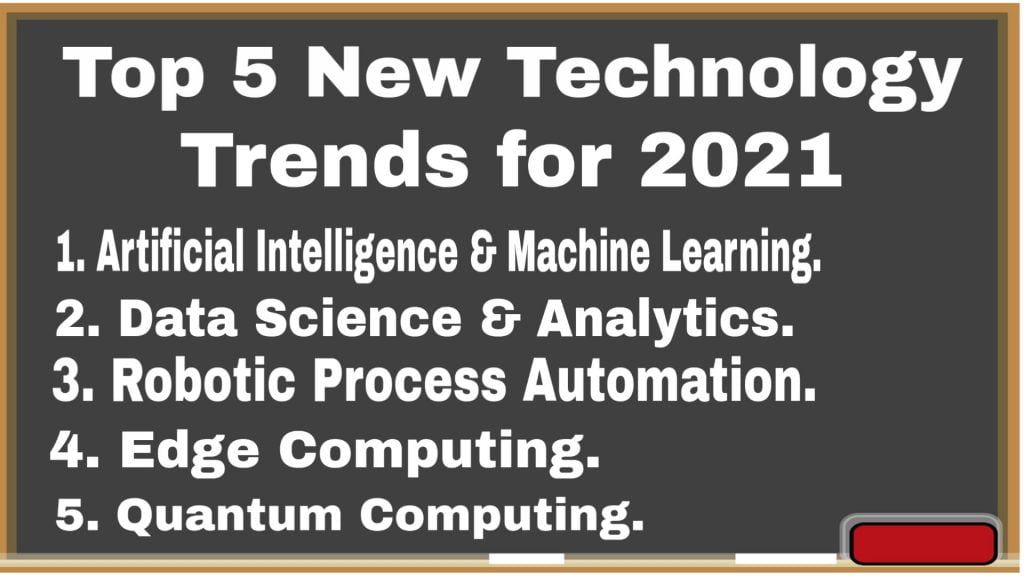Top 5 New Technology Trends for 2021
Change is the only constant. This applies to your professional life as well. Up-skilling yourself is a need nowadays, the reason is pretty simple, technology is evolving very quickly. We need to identify and invest our time in the Top 5 Trending Technologies which will attract a huge market in 2021.
Here is the list of the top 5 new and trending technologies:
- Artificial Intelligence (AI) and Machine Learning.
- Data Science & Analytics.
- Robotic Process Automation (RPA).
- Edge Computing.
- Quantum Computing.
1. Artificial Intelligence (AI) and Machine Learning.
AI has continued to improve operations for many companies and businesses. The pandemic even made its usage more common. AI, data, and machine learning have played an unmatched role during this corona-virus period.
We have seen how AI has helped in the suggestions customers get when shopping on Amazon, or even when they are watching movies on Netflix. More companies will benefit from AI since the cloud continues to enable access to the rising computing power, software, and frameworks. It’s estimated that 45% of companies using artificial intelligence have increased their total spend per customer, and their ASPs.
2. Data Science & Analytics.
Data Science is the sexiest job has become an old statement now. According to a report by Statista, the revenue from big data applications and analytics is expected to grow from $5.3B in 2018 to $19.4B in 2026. The job role of a data scientist continues to be in the top 3 in any survey, be it by LinkedIn or Glassdoor. With its application across different industries: finance, IT, health, and more, this is the latest technology that you should learn in 2021.
3. Robotic Process Automation (RPA).
RPA is an application of technology, governed by business logic and structured inputs, aimed at automating business processes. Using RPA tools, a company can configure software, or a “robot,” to capture and interpret applications for processing a transaction, manipulating data, triggering responses and communicating with other digital systems. RPA scenarios range from something as simple as generating an automatic response to an email to deploying thousands of bots, each programmed to automate jobs in an ERP system.
RPA actual deployment
- Banking and Finance Process Automation
- Mortgage and Lending Process
- Customer Care Automation
- eCommerce Merchandising Operation
- OCR Application
- Data Extraction Process
- Fixed automation process
Benefits of RPA
In addition to business process like the ones we just examined in finance, customer service, and HR, what are the other benefits of RPA? Think about what your organization could do with the reclaimed IT team time.
4. Edge Computing.
In any business or industrial scenario wherever assembling mass amounts of information is at play, Edge Computing technology offers organisations the flexibility to sift through information and confirm what has to be prioritized and sent over the network and also the less-pertinent information may be sent to the data center for storage. This helps to minimize the quantity of information crossover within the network.
There are far too many examples of edge computing use cases to list here, so we’ve chosen 10 important ones below:
- Autonomous vehicles
- Remote monitoring of assets in the oil and gas industry.
- Smart grid.
- Traffic Management
- Predictive maintenance.
- In-hospital patient monitoring.
- Smart Homes.
- Virtualised radio networks and 5G (vRAN).
- Cloud
- Content delivery.
5. Quantum Computing.
Quantum computers are machines that use the properties of quantum physics to store data and perform computations. This can be extremely advantageous for certain tasks where they could vastly outperform even our best supercomputers.
They won’t wipe out conventional computers, though. Using a classical machine will still be the easiest and most economical solution for tackling most problems. But quantum computers promise to power exciting advances in various fields, from materials science to pharmaceuticals research. Companies are already experimenting with them to develop things like lighter and more powerful batteries for electric cars, and to help create novel drugs.
